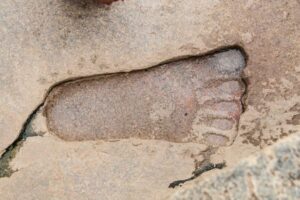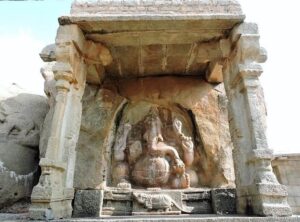With the covid-19 situation making people’s lives a little harder to live, I thought maybe I could give you a piece of information that might make you see the bright side of all that’s happening right now. We know well that India owns a lot of beautifully constructed temples and people are also curious to know the mystery as to its construction and myths behind it. I’m going to bring to light yet another temple whose architecture is a marvel during its times and is a mystery even now. The Lepakshi temple hanging pillars. You heard me right, ‘hanging pillars’. Basically breaking rules of physics, let’s see more about why this temple is so special.
LEPAKSHI TEMPLE HANGING PILLARS- HISTORY
Let’s start off with where is Lepakshi temple is. The beautiful 16th-century Lepakshi Veerabhadra temple, also renowned as Lepakshi temple. It is situated in the ancient village of Lepakshi in the Anantapur District of Andhra Pradesh, India, around some 15 kilometres east of Hindupur and 120 kilometres north of Bangalore.
The Lepakshi temple hanging pillars, Andhra Pradesh, was designed in the traditional Vijayanagara style. Moreover, It has numerous fine statues of gods, deities, performers, and singers and hundreds of paintings on the walls, columns, and ceiling showing narratives from the Mahabharata, Ramayana, and Puranas epics. This features a fresco of Veerabhadra that measures 24 feet by 14 feet. . In addition, a massive Nandi (bull), Shiva’s mount, stands in front of the temple and is considered being one of the largest of its kind in the world, carved from a single block of stone.
ARCHITECTURE OF THE TEMPLE
Let’s go back to basics. In the classic Indian epic Ramayana, the village of Lepakshi plays an important role. According to legend, after an unsuccessful battle against Ravana(king of Lanka), who was hauling away Sita who was the wife of Rama (ruler of Ayodhya), the bird Jatayu crashed here. When Rama arrived at the location as Jatayu was on the verge of dying, he noticed the bird and said gently, “Le Pakshi,” which means “Arise, bird” in Telegu.
Now to the question of who built the Lepakshi temple. The brothers Viranna and Virupanna, who were Rulers of the Vijayanagar Empire during King Achutaraya’s reign, constructed the Veerabhadra temple under the care of sage Agastya which is noted to be the most exquisitely built temple in the Vijayanagar architectural style. Walking around the temple reveals the splendour of the Vijayanagara dynasty, which financed the creation of these extraordinary artistic representations. They carved figures of musicians and saints into the walls. We’ll also see a lovely Ganesha moorti dancing, as well as Mata Parvati and Lord Shiva murtis. Here is also where Sage Agasthya is reported to have dwelt in a subterranean chamber.
THE LEPAKSHI TEMPLE HANGING PILLAR

There is one stone pillar that descends from the ceiling among the 70. The pillar’s base barely reaches the ground, allowing materials like a thin piece of paper or a shred of fabric to pass through. The pillar is supposed to have become displaced from its original position when a British engineer tried unsuccessfully to find the secret of its stability by moving it.
It’s mind-boggling to even consider what techniques would have been used to construct such a fine space in between the pillar’s underside and the rough stone floor underneath it. As though a twig were slowly creeping under the pillar. Alternatively, you might place a sheet between the pillar’s base and the floor beneath it. This magnificent rock temple in Vijayanagar architecture has nearly 70 pillars, but this one is the most well-known and a testimony to the engineering expertise of the ancient and mediaeval period of India’s temple architects.
MORE TO THE MYSTERY
The Aakaasa Sthambha is the term for the hanging pillar.
Illustrations of a holy presence, performers, saints, singers, and 14 Shiva incarnations adorn the temple’s pillars and walls. In the Lepakshi Temple, there are three unique Mandapas. The first is Mukhya Mandapa (or Natya or Ranga Mandapa), the second is Artha Mandapa and Garva Griha, and the third is Kalyana Mandapa. The last Mandapa is still incomplete.
The temple is situated on Kurmasailam, a low, rocky hill that translates as “tortoise hill” in Telugu. The hill has the shape of a tortoise. We worship Shiva in a fierce temper known as Veerabhadra by devotees.
Aside from the Lepakshi temple’s hanging pillars, there’s also the Nandi, which is a mile before the temple’s entrance gate. It is India’s largest freestanding sculpture, spanning 27 feet long and 15 feet wide. Ganesha, Nandi, Veerabhadra, Shiva, Bhadrakali, Vishnu, and Lakshmi have idols in Lepakshi Temple.
LEPAKSHI TEMPLE PAINTINGS
The dome painting of Veerabhadra in the entranceway is India’s largest single figure painting. The principal theme of the frescoes in the inner hall are tales of Rama and Krishna from the famous epics Ramayana, Mahabharata, and Puranas, and the artwork is done in fresco method with vibrant colours. A mural depicting a flock of geese carrying lotus shoots in their beaks is fascinating.
The exterior of the Lepakshi temple hanging pillars is stunning and vibrant, with a mix of organic and mineral colours. The entrance gate has magnificent statuettes of the goddesses Yamuna and Ganga. They embellished the external columns with engravings of soldiers and horses, which rendered a marvel to visitors.
Lord Brahma is playing the drums, Rambha, the heavenly woman, is dancing, and Lord Shiva is doing the ‘Ananda Tandava.’ The sculptures of dancing nymphs sure mesmerise people who come to visit. They decorated the southwest hall with a picture of Parvati surrounded by female servants.
LEPAKSHI TEMPLE SHIVLING
Closely from the pillar, there stands a Shivling that is hooded under the multifaced snake. If they had completely constructed the temple during its time, Lord Shiva and Ma Parvati’s marriage would have taken place here in this Kalyan Mantapa.
While the monarch was away on a trip, the treasurer for the time being began construction. When the King returned, they enraged him that the accountant had spent the kingdom’s money on this construction without his knowledge or agreement (I feel it was more of an ego clash that the king had). He promptly ordered the construction of the Kalyan Mandapa to be halted. As a result, it remains unfinished to this day.
THE LEPAKSHI TEMPLE HANGING PILLARS: FOOTPRINT OF SITA

Moving on, you’ll come across a massive footprint on the temple floor after passing the Kalyan Mandapa.
It was almost as if someone stomped their foot on the floor with force. We believe that Goddess Sita’s footprint is here. This footprint is usually damp. We may see water regularly skimming and bathing this foot from beneath. The origins of this water remains an open question. However, because it is the holy Goddess’s footstep; the water emerges miraculously as a symbol of reverence to her. The myth is that Ravana stopped at this shrine to relax while abducting Goddess Sita and transporting her to Sri Lanka. We consider this to be the origin of the footprint found on the temple grounds’ floor.
HOW TO REACH THE TEMPLE

Darshan is available at Lepakshi temple from 6 a.m. to 6 p.m. every day. They perform Abhishek between the hours of 7 and 7:30 a.m. Also, Darshan is available every day of the week. Before your visit, gather precise information about the temple’s schedules. They may change during festivals, major rituals, or during an eclipse. We worship the Shivaling first, followed by Lord Veerabhadra’s contributions. During the morning puja, they adorn the lord in Bala Rupa (youth) and has a moustache added to his visage to show him as a hero.
It’s important to remember that the normal dress code in this city is modest clothing. Carry no belts, leather purses, or similar items. Inside the temple, they do not ban photography. The closest railway is Hindupur, which is around 13-15 kilometres away from the area.
Direct trains from Mumbai, Delhi, Bengaluru, Chennai, Ahmedabad, Jaipur, and other cities in India serve Hindupur. Once you arrive at the Hindupur railway station, you can take a cab or a bus to the Lepakshi temple.
CONCLUSION
In the beginning, I mentioned a bright side to the pandemic situation, and this is it. A visit to the breathtakingly beautiful temple with your family and loved ones might be something to look forward to. Moreover, this temple’s aesthetic and historical beauty attracts pilgrims from all over the world. To end this on a mysterious note, the legend has it that the treasurer who was found guilty of misusing the royal treasury to build this temple and was sentenced to blindness by the king, who, because he was a devoted person, carried out the sentence with his own hands on the spot. There are dark stains on the wall near the ‘Kalyana Mandapam’ that bore witness to this tragedy. As a result, we know the village as Lepa-akshi or Lepakshi, which means “blind eye village.”
Comments